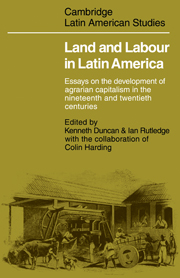 Land and Labour in Latin America
Land and Labour in Latin America Published online by Cambridge University Press: 07 May 2010
The nature of the hacienda system: the conflict between landlord and peasant enterprises
In this paper I shall attempt to explain the changes in the Chilean hacienda system which has dominated rural society since colonial times. Although the hacienda system has until recently retained many of its traditional features, largely by maintaining its economic, social, and political predominance in the countryside, nonetheless it has experienced cumulative changes which have gradually undermined the unity of the hacienda as a system, transforming it from a large multi-farm estate, characterized by a complex of traditional landlord–peasant relationships, to a single-farm estate, characterized by farm manager–wage labour relationships. The pressures for change have come from sources largely external to the hacienda system. Among the important causes of the transformation of the Chilean hacienda system must be mentioned the changes in the market (both internal and external), the growth of the urban population, and the increasing radicalization and political organization of the urban working class and later of the peasantry. This analysis will focus on the changes which these factors provoked in the hacienda system, particularly in its labour structure.
Perhaps I should spare a few lines explaining my conceptual approach to the problem, especially in the hope that other analysts might find it useful when studying landlord–peasant relationships in regions dominated by the large landed estate. I shall adopt the ‘multi-enterprise approach’ first presented by Rafael Baraona in his study on the nature of the hacienda in the Ecuadorean Sierra. The multi-enterprise approach views the hacienda system as a conflicting unity between two types of agricultural enterprise: the landlord and the peasant.
To save this book to your Kindle, first ensure [email protected] is added to your Approved Personal Document E-mail List under your Personal Document Settings on the Manage Your Content and Devices page of your Amazon account. Then enter the ‘name’ part of your Kindle email address below. Find out more about saving to your Kindle.
Note you can select to save to either the @free.kindle.com or @kindle.com variations. ‘@free.kindle.com’ emails are free but can only be saved to your device when it is connected to wi-fi. ‘@kindle.com’ emails can be delivered even when you are not connected to wi-fi, but note that service fees apply.
Find out more about the Kindle Personal Document Service.
To save content items to your account, please confirm that you agree to abide by our usage policies. If this is the first time you use this feature, you will be asked to authorise Cambridge Core to connect with your account. Find out more about saving content to Dropbox.
To save content items to your account, please confirm that you agree to abide by our usage policies. If this is the first time you use this feature, you will be asked to authorise Cambridge Core to connect with your account. Find out more about saving content to Google Drive.